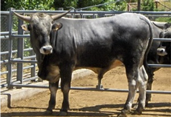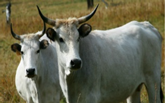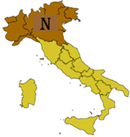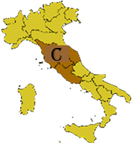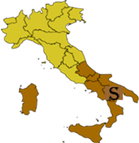Abstract
In the context of the general phenomenon of diminishing genetic diversity, especially in cattle, the conservation of endangered species plays a primary role. The disappearance of some animal populations can irreparably affect the biodiversity of genetic resources. Among the most ancient European cattle are breeds that belong to the Podolian group, the history of which is still not well established. The common origin of these breeds is the wild ox (Bos taurus primigenius), which has been declared extinct since the 17th century. The purpose of this paper is to highlight and compare the latest studies on the origin, evolution, genetic diversity, and phylogenetic relationships of Podolian cattle, with special emphasis on the endangered Romanian Grey Steppe. The importance of studying these cattle derives from the special biological properties by which they have distinguished themselves over time (adaptability and resistance to diseases, severe climate and habitat conditions, hardiness, and longevity). The bibliographic references reviewed in this study confirm that these breeds are carriers of valuable genes that must be preserved for improvement of other cattle and protection of biodiversity. The information presented represents a valuable tool for efforts to conserve endangered cattle.
1. Introduction
Throughout history, humans have been mainly focused on raising cattle. Initially, the emphasis was on meat and using them in the agricultural sector, transport, and construction. As time progressed, there was a shift towards prioritizing milk production. Cattle hold significant importance as a livestock species, playing a crucial role in shaping human history, culture, and civilization. The evolutionary history and genetic diversity of cattle are controversial and essential topics in this field.
Bos primigenius primigenius and Bos primigenius namadicus, two major wild aurochs subspecies that are common in Africa and Eurasia throughout the Middle Pleistocene, are the origin of the convoluted evolutionary history of cattle. Their domestication led to the current Bos taurus taurus (taurine) and Bos taurus indicus (zebuine) subspecies, which were separated approximately 250,000 years ago (YBP) [,,]. Since domestication, which took place roughly 10,000 BC in the Fertile Crescent (B. t. taurus) and roughly 8000 BC in the Indus Valley (B. t. indicus) [,], cattle have followed colonization routes concurrently with Neolithic human expansion.
In terms of phylogenetic analysis and mitochondrial DNA evidence, the T haplogroup stands out as the predominant mitochondrial lineage in both contemporary and ancient Neolithic European cattle. It is thought to have originated during the domestication event in the Fertile Crescent; nevertheless, other rare lineages are also scattered throughout Europe. Several studies have confirmed the presence of a P lineage, primarily identified in central and northern European aurochs. This lineage is also observed in certain contemporary taurine breeds and ancient domestic cattle. Additionally, the Q lineage is found in various European cattle and is recognized as part of the so-called Podolian trunk. An indicine gene pool component was observed in diverse breeds, such as the Turkish Grey and some Italian breeds that belong to the SO group (Chianina, Romagnola, Marchigiana, Romanian Grey Steppe, Maremmana, and Podolica Italiana). According to many studies, Podolian breeds are characterized by grey coats and upright and often long horns, with a common ancestral origin in Podolia (modern western Ukraine) [,,,,,,,]. The development of these breeds was significantly and favorably influenced by environmental conditions, which played a crucial role in shaping distinctive biological characteristics. These cattle experienced lower selective pressure, with limited use of artificial insemination and higher natural selection. Podolian breeds were typically raised in natural environments, where activities such as foraging for food, maternal care, and other natural behaviors were essential. This stands in contrast to other improved breeds that underwent different selection pressures and breeding practices. Regarding the origin and timing of the spread of the Podolian cattle, molecular evidence shows two alternative hypotheses: some authors suggest that Podolian cattle might have spread from the eastern steppe southward into Anatolia and westward into the Balkans and Italy in historical times (3rd–5th century AD) along with East European Barbarian people [,,]; other authors suggest a more ancient migration (~3 kya BP) from the Near East to Central Italy through the Mediterranean Sea, together with a possible contribution from local wild aurochs through secondary local domestication/introgression events [,,,,,].
According to the Food and Agriculture Organization (F.A.O.), many Podolian breeds are seriously threatened by extinction in various European countries. Currently, this cattle group represents an important topic of discussion in scientific circles in European nations.
This study focused on the endangered Romanian Grey Steppe cattle, a valuable reservoir of genes with high importance for Romanian agriculture, belonging to the category of Podolian breeds, which have been threatened with extinction since 2000 according to the F.A.O. [,,].
Archaeological and genetic evidence proves that the progenitor Bos taurus primigenius (B. t. primigenius), which was declared extinct in the 17th century [], is the ancestor of Podolian cattle and the wild ancestor of all the present-day breeds [,].
Owing to their valuable genetic pool for greater disease resistance and high adaptability to harsh environmental conditions, the Grey Steppe cattle are included in a genetic conservation program. Moreover, these indigenous cattle breeds form an integral part of our nation’s history [,,,,].
In the last decade, the population of the Grey Steppe breed has registered a significant numerical decrease []. Additionally, isolated individuals count to approximately 100 heads spread in the Danube Delta and the counties of Iasi, Neamt, and Pardina, northeastern Moldova [,,]. A population of these cattle, which is part of a national genetic conservation effort, can currently be found at the Research and Development Station for Cattle Breeding in Dancu, Iasi, Romania.
Romanian Grey cows have a narrowed milk production, which is mainly used for calf feeding. They have a medium slaughter yield, and the bulls get to the slaughter weight at an older age compared to bulls of early maturing breeds (Angus, for instance). Their meat is darker and not particularly marbled as most of the suet forms subcutaneously, and their intestinal fat deposits have a lower arrangement of fat at the intramuscular level.
The majority of Grey Steppe varieties in Europe were not specifically bred for milk production. Instead, these were primarily raised for meat or as draft animals, leveraging their sturdy hooves, robust skeletal structure, and well-defined joints, which made them well-suited for tasks requiring strength and endurance. Cows raised in households typically yield around 800–900 kg of milk per year, while those on farms produce higher quantities ranging from 1000 to 2500 kg. The milk from these cows generally has a fat content of 4–6%. In terms of slaughter yield, oxen exhibit a medium yield of approximately 50–51%, whereas cows have a slightly lower yield with a range of 47–49%. [,,,,,].
The preservation of local breeds is an important aspect of food security given the recent climatic changes as well as extreme phenomena that could bring new challenges in the future, with bovine species being the most exposed to these changes. Therefore, the Grey Steppe cattle could be an effective alternative to other improved breeds due to their special biological qualities. Owing to their valuable genetic resources, numerous studies in the specialized literature have demonstrated the importance of local cattle breeds in genetic conservation programs [,,,,].
This paper reviews the most important research in the specialized literature regarding the origin, phylogeny, and genetic diversity of Podolian Grey Steppe in the context of its importance for preserving biodiversity and sustainable conservation of genetic resources.
2. The Importance of Cattle Biodiversity
Due to numerous advantages, including the rich nutritional content of raw animal products like milk and meat, cattle breeding plays a significant role in food and nutrition security. The conservation and sustainable utilization of cattle genetic resources are crucial due to the diverse benefits offered [].
2.1. The Bovine Species: Origin, Evolution, and Domestication
Along with sheep and goats, according to the first archaeological evidence, cattle were domesticated about 10,000 BC (Figure 1A) [].
The domestication of cattle represented a fundamental step in the development of humanity [,], leading to extensive changes in the diet, behavior, and socioeconomic structure of many populations. Genetically, the domestication process of animals can be reconstructed by employing phylogeographic analyses that rely on data from both the nuclear and mitochondrial genomes []. However, molecular studies in cattle have focused on the analysis of mitochondrial DNA (mtDNA) [,]. The wild ancestor of all domesticated cattle is B. primigenius [], currently an extinct species, with the last recorded herd being found in 1627 A.D. in Poland [,,]. It spread over much of Eurasia and North Africa during two major epochs, the Late Pleistocene and the Early Holocene [], giving rise to two taxa (Figure 1C) that played a crucial role in the domestication of today’s cattle.
The ancestors B. taurus and B. indicus are differentiated primarily by the presence of a hump (specific to B. indicus). The presence of a hump in B. indicus contributes to physiological adaptation and effectively dissipates heat; this adaptation is particularly important in warm tropical environments. The hump is primarily composed of a deposit of fatty tissue located on the back of the animal, just behind the neck and shoulders. This fatty tissue serves as an energy reserve, but its presence also plays a crucial role in the thermoregulation of body temperature [,,].
The genus B. taurus encompasses the characteristic bulls found in Europe, Northeast Asia, and North Africa, specifically adapted to cold climates []. Various studies have consistently shown that modern European cattle breeds within the genus B. taurus fall under the mitochondrial haplotype T [,]. Regarding B. indicus (zebu), studies show India as the center of origin, later spreading to Africa and Southeast Asia in the period 2250–2000 BC, with zebu cattle later identified as being scattered all over India. As far back as the Harappan civilization in the Indus Valley, figures and paintings have been found depicting humped cattle resembling the ancestor B. primigenius (Figure 1B,C).
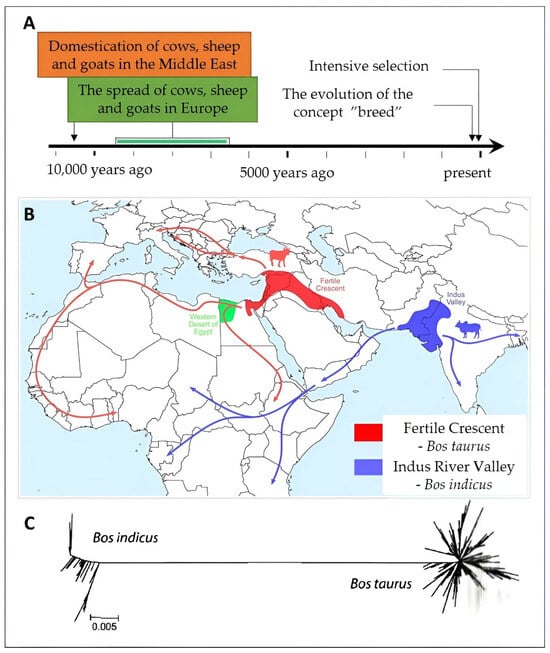
Figure 1.
Archaeological data on the domestication of cattle, sheep, and goats. (A) Domestication centers. (B) Map of domestication centers for B. indicus—Indus River Valley and B. taurus—Fertile Crescent. (C) Unrooted neighbor-joining trees illustrating the mtDNA polymorphism of cattle, sheep, and goats. Graphic adapted: Copyright © 2008 S. Karger AG, Basel-Hiendleder et al. [] and Copyright © 2011 Académie des sciences. Published by Elsevier SAS-Taberlet et al. [].
Allchin (2008, 2009) posits that the domestication of animals in India occurred through the efforts of two distinct groups. The first group consisted of hunters dispersed across the country during the Stone Age who engaged in the domestication of certain local animal species. The second group comprised nomadic shepherds originating from western Asia [,]. The zebu bull, depicted on the Harappan seal, resembles the modern cattle of Gujarat, with a strong body and massive horns.
Certain cave paintings found on the oldest Neolithic rocks portray zebu cattle characterized by a light build and prominent humps, showcasing distinct differences from northern cattle []. The spread of domesticated cattle across Europe coincided with the migration of first-generation farmers. As they settled in regions that harbored native European bulls, sporadic interbreeding between domesticated and native bulls occurred, which persisted in some regions until the Middle Ages.
Drawing on archaeological and genomic evidence, Taberlet et al., (2011) [] showcased the existence of two mitochondrial haplogroups, suggesting two principal domestication events. The first event occurred in the Fertile Crescent during the Neolithic period, contributing to the domestication of B. taurus. The second event, transpiring 1500 years later in the Indus Valley (present-day Pakistan) within the Indian subcontinent, led to the emergence of Indian cattle belonging to the B. indicus subspecies, commonly known as zebu []. Extensive hybridization has subsequently occurred in Africa [,,].
Another study developed by Hiendleder et al., (2008) aimed to analyze complete mitochondrial genome sequences (16,338 bp for B. taurus and 16,339 bp for B. indicus), which indicated that the two bovine lineages separated 1.7–2.0 million years ago. Comparative phylogenetic analyses between 18 new sequences and 130 previously reported sequences in B. taurus and B. indicus with data from 32 specimens (B. primigenius) identified a maternal lineage across four genetic lineages. B. primigenius haplotypes were present in all but the B. indicus lineage, and one sequence from B. taurus clustered with B. primigenius, namely, the P haplotypes [].
Achilli et al., (2009) conducted an extensive study on the origin of taurines based on mitochondrial genome analysis. By researching mtDNA control regions associated with taurines from numerous European breeds, a general grouping within haplogroups T1, T2, and T3, common to ancestors from the Near East, was confirmed, but eight mtDNA regions were also identified (1.3%) that did not fit into haplogroup T. The sequencing of the complete mitochondrial genome led to the hypothesis that four out of the eight mtDNA regions constituted a new haplogroup (haplogroup R). This haplogroup, following a bifurcation that resulted in two lineages, taurine and zebu, represented the oldest known split in the mitochondrial DNA phylogeny of the genus B. primigenius. The remaining four mtDNA regions formed the haplogroup Q, a discovery made more recently (Figure 2) [].
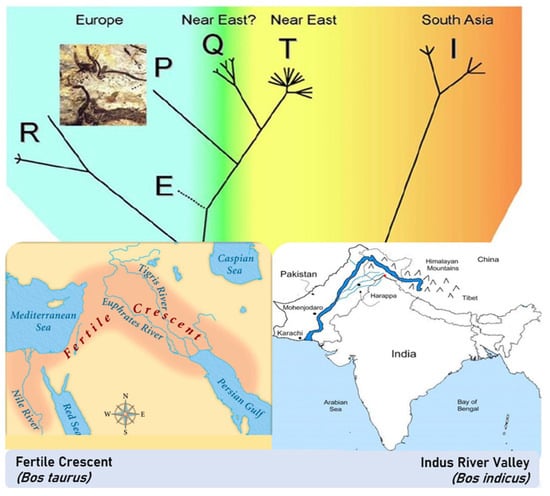
Figure 2.
Phylogenetic analysis of cattle based on mtDNA haplogroups—R, E, P, Q, T, I. Graphic adapted: Copyright: © 2009 Achilli et al. [].
The available data suggest that haplogroups Q and T were involved in the same Neolithic Near Eastern domestication event, while the existence of new (and rare) haplogroups points to genetic inheritance from distinct populations of B. primigenius [,,].
Another analysis of the phylogenetic relationships between the aurochs and B. taurus (taurines) and B. indicus (zebu) was carried out by Sinding and Gilbert (2016) based on mitochondrial studies of seven lineages, C, I, P, Q, R, and T (Figure 3) []. This suggests that the domestication of the aurochs occurred through at least two distinct events: one leading to taurines (B. taurus) originating in the Near East, and a second event resulting in zebu (B. indicus) originating in South Asia [,].
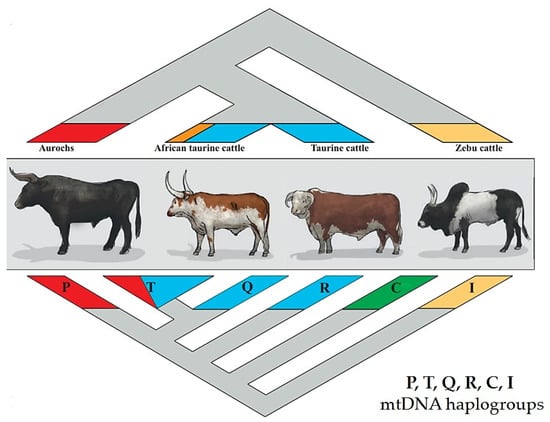
Figure 3.
Boviadae family cluster based on phylogenetic analysis between B. primigenius, B. taurus, B. indicus, and African taurine (neighbor-joining algorithm). Graphic adapted: Copyright: © 2016 Sinding et al. [].
By interpreting mitochondrial data in detail, three important aspects can be observed. First, most modern taurines belong to the T lineage, which is believed to have been derived from the first domesticated taurines in the Near East. Second, all zebu cattle carry lineage I. The distinct sister relationship of this clade with all other lineages was as expected given zebu’s independent domestication. For this lineage, the highest genetic diversity was observed within the Indus Valley, which is one of the hypothesized domestication centers alongside South India [,]. Third, all remaining northern, central, and eastern European aurochs studied to date carried lineage P. The P lineage has also been identified in some modern taurine breeds and ancient European domestic cattle, suggesting the introgression of northern, central, and/or eastern European aurochs [,,,].
Approximately 200 years ago, with the emergence of the concept of breed, the situation changed dramatically because of the selection process [,], which led to the fragmentation of the initial genetic background. The enhancement of production performance in industrial breeds has coincided with a decline in the genetic resources of traditional native breeds, leading to the extinction of many cattle breeds. The genetic diversity of both B. taurus and B. indicus cattle has been diminished, primarily concentrating on breeds with high production potential. Most wild varieties of cattle have already disappeared or are in danger of extinction, as is the case for the Podolian cattle group that is the subject of this study.
2.2. Systematics and Phylogeny of Cattle
The Bovidae family presents a great variety, with more than 300 extinct or endangered species described and approximately 140 existing species [], which is extremely difficult to achieve, representing one of the largest groups of mammals. According to taxonomic data, cattle are classified as follows: animal kingdom—nimalia; subkingdom—Metazoa; phylum—Chordata; subphylum—Vertebrata; class—Mammalia; subclass—Eutheria; order—Artiodactyla/Paricopitatae; family—Bovidae; subfamily—Bovinae; tribe—Bovini [].
Due to its importance as a primary source of food (milk and meat), cows were the first mammal whose genome were completely sequenced [,]. Advances in genome sequencing analysis have simplified the molecular systematics of the Bovidae family.
The analysis of both the complete genome and mitochondrial regions, as represented by the cytochrome b gene (Cyt-b) and the mitochondrial control region (D-loop), has attracted considerable attention in the phylogenetic analysis of various taxa [].
Despite ongoing research efforts, the phylogenetic relationships and taxonomy within the Bovidae family remain contentious. There have been numerous controversies over time concerning the taxonomy of the Bovidae family. According to some authors [,], it comprises two major subfamilies, Bovinae and Antilopinae, with origins in both Eurasia and Africa []. According to studies conducted by Feldhamer et al., (2007) and Gentry (2011), based on phylogenetic analyses, the Bovidae family consists of eight distinct subfamilies belonging to the Artiodactyla order (Figure 4A,B) [,]. The same hypothesis is also supported by Hernandez Fernandez M. and Vrba Elisabeth (2005), who, as part of research on the systematics of the Bovidae family, developed a phylogenetic tree that includes the eight subfamilies (Figure 4B) [].
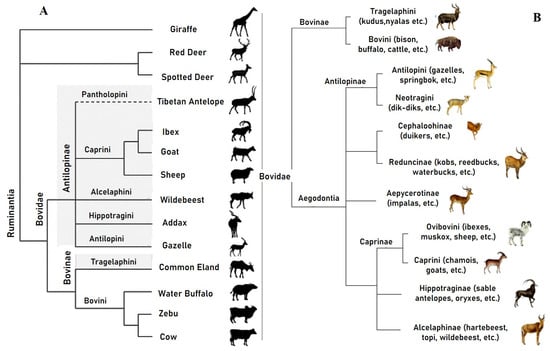
Figure 4.
(A) Phylogenetic tree representing 11 species: two subfamilies and seven tribes belonging to the Bovidae family and two ruminant families used as out groups (giraffe and deer). (B) Systematics of the Bovidae family. Graphic adapted: Copyright: © 2015 Dekel et al. [] and Hernandez-Fernandez et al. [].
Dekel et al., (2015) analyzed the TP53 P1 promoter (a key tumor suppressor gene that is indispensable for diverse developmental processes) of three species of the subfamily Bovinae: one belonging to the tribe Tragelaphini (the spiral-horned eland—Taurotragus oryx) and two belonging to the tribe Bovini (water buffalo—Bubalus bubalis and zebu—B. indicus). In the case of the zebu and buffalo species, similar to the Bovinae species, an additional long segment of 272 bp (base pair) was not found, whereas in the common antelope, this segment was identified with a length of 522 bp. Examination of the same promoter region in two families closely related to Bovidae, Cervidae (represented by the axis axis—Indian Spotted deer/chital) and Girraffidae (represented by the giraffe, Giraffa camelopardalis), did not reveal any insertion, similar to the Bovinae species (Figure 4A) [].
Bovines, belonging to the subfamily Bovinae, form a diverse group encompassing 10 genera of medium- to large-sized ungulates. This group includes various species such as cattle, bison, African buffalo, water buffalo, and both four-horned and spiral-horned antelopes. The evolutionary relationships among members of this group remain a subject of debate, and their classification into loose tribes rather than formal subgroups reflects the ongoing uncertainty in this field [,].
Antilopinae belonging to the Bovidae family include antelopes, gazelles, and other related species. These are even-toed ungulates and occur in much of Africa and Asia, with the highest concentration of species occurring in East Africa in Sudan, Eritrea, Ethiopia, Somalia, Kenya, and Tanzania []. Another subfamily of the Bovidae family is Cephalophinae, which includes forest antelopes, which are widespread in the area of sub-Saharan Africa and are classified into three genera (Cephalophus, Philantomba, and Sylvicapra) and 18 species [].
The Bovidae family is widely spread, including the subfamilies Reduncinae [,], composed of nine species of antelope, all of which dwell in marshes, floodplains, or other well-watered areas, including waterbucks and reedbucks; Aepycerotinae, an African antelope that contains a single living species, the Impala []; and Alcelaphinae, a subfamily with under 10 species, grouped in turn into four genera [].
The subfamily Caprinae, also sometimes referred to as the tribe Caprini, is part of the ruminant family Bovidae, and consists mostly of medium-sized animals, including sheep (Ovis) and goats (Capra) and mountain-adapted mammals with either short and sharp horns or large and ornate horns. The geographical distribution is represented by Europe, America, Africa, and Asia [].
The last subfamily, according to the above tree, is Hippotraginae, which is represented by large antelopes. This subfamily includes three genera, Hippotragus, Oryx, and Addax, and eight species. Their habitats are represented by areas in Africa and the Middle East [,,,].
3. The Origin and Phylogeny of the Podolian Cattle Breeds
Podolian cattle constitute a group of breeds distinguished by grey coats and upright and often long horns that are believed to have originated in the Podolian steppe. These are classified by geographical area as follows: Podolian Grey Steppe breeds from Eastern Europe, Podolian–Istrian breeds from Central Italy, and Podolian–Illyrian breeds from the Balkans and Anatolia, as shown in Table 1.

Table 1.
Classification of Podolian cattle breeds according to their geographical distribution.
Podolian cattle exhibit morphological variations primarily attributed to their adaptation to the specific climatic conditions of their geographic region. The distinctive characteristics of these cattle result from the influence of the natural environment (Table 2).

Table 2.
Morphological characteristics of Podolian grey cattle.
Notable differences in body development are evident in breeds such as Istrian Grey, with an average wither height of 148 cm for males and 138 cm for females, as well as in the Hungarian Grey Steppe breed, with an average wither height of 150 cm for males and 140 cm for females.
Podolian cattle breeds are known for their adaptability to extreme conditions and hardiness against diseases. “Podolica/Podolian” indicates a possible origin of these breeds in Podolia (a region of Ukraine) [] and their spread southward to Anatolia and westward to the Balkan and Italian peninsulas [].
The results of Senczuk et al., (2021) indicated that Podolian cattle show higher values of genetic diversity indices than African or Asian cattle breeds. Analysis of mitochondrial DNA revealed close phylogenetic relationships among Podolian breeds, indicating a shared genetic ancestry (Figure 5) and a common evolutionary history [].
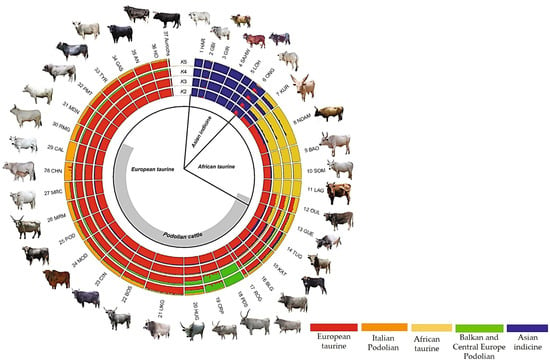
Figure 5.
Analysis of the phylogenetic relationships between Podolian cattle breeds and African/Asian cattle breeds. Graphic adapted: Copyright: © 2021 Senczuk et al. [].
Di Lorenzo et al., (2018) conducted a study on the origin of Podolian cattle through mitochondrial DNA analysis. The biological material for the study comprised 18 breeds within the Podolian group (Piedmontese—PI, Romagnola—RO, Marchigiana—MR, Chianina—CH, Maremmana—MA, Podolica Italiana/Italian Podolian—IP, Mucco Pisano—MP, Calvana—CA, Bianca di Val Padana—BP, Hungarian Grey—HG, Bulgarian Grey—BG, Istrian cattle—IC, Katerini—KA, Romanian Grey—RG, Slavonian–Syrmian Podolian—SS, Turkish Grey—TK, Ukrainian Grey—UK, and Podolsko—PO) and 9 non-Podolian breeds, representing the control group (Valdostana—VA, Bruna Italiana—IB, Grigio Alpina—GA, Pezzata Rossa Italiana—RP, Modicana—MO, Reggiana—RE, Agerolese—AG, Cinisara—CI, and Cabannina—CB). Following this study, genetic closeness was found between five cattle breeds (Chianina, Marchigiana, Maremmana, Podolica Italiana, and Romagnola) (Table 3 and Figure 6) [].

Table 3.
Cattle breeds from the northern (N), central (C), and southern (S) areas of Italy; Podolian breeds (P-underlined) non-Podolian breeds (non-P) [].
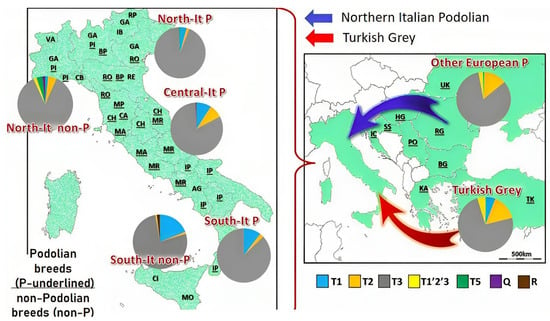
Figure 6.
Analysis of frequency distributions of mitochondrial haplogroups for 18 Podolian breeds (P-underlined) and 9 non-Podolian breeds (non-P). Graphic adapted: Copyright: © 2018 Piera Di Lorenzo et al. [].
A plausible hypothesis posits a dual ancestral contribution to the present genetic background of Podolian breeds stemming from both Eastern European and Middle Eastern cattle.
3.1. Romanian Grey Steppe: Origin and Phylogeny
In Romania, Grey Steppe cattle represent one of the oldest autochthonous breeds, formed in the pedoclimatic conditions of the country, with its origin in B. t. primigenius (wild ox).
According to the research by Carsai (2008), until around 1850, the total taurine in Romania was predominantly represented by the Grey Steppe breed. Since 1892, with the first imports of non-native breeds (Simmental, Schwyz, and Pinzgauer), the local breeds have faced a sharp decline. Thus, the numerical total had decreased to approximately 57.3% of the total cattle in 1935 and to only 0.6% in 1977 [,,].
This breed is included alongside other breeds in the Podolian group found in various European countries (Podolica Italiana/Italian Podolian, Hungarian Grey, Bulgarian Grey, Istrian cattle, Katerini, Turkish Grey, Ukrainian Grey, etc.) (Figure 7) [,,,].
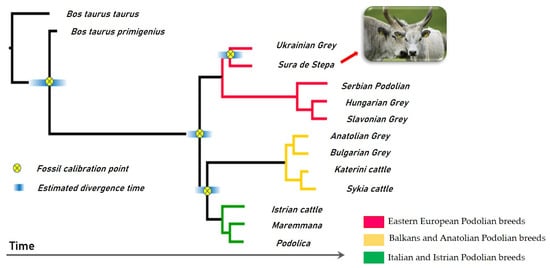
Figure 7.
Phylogeny relationships between Romanian Grey Steppe and Podolian cattle breeds. Graphic adapted: Copyright: © 2018 Piera Di Lorenzo et al. [].
A crucial aspect is that the natural environment played a nearly exclusive role in shaping and evolving the Romanian Grey Steppe breed. This environmental influence endowed the breed with distinctive qualities such as hardiness, resistance, adaptability to various maintenance conditions, and specific feeding methods [].
The external peculiarities of this breed distinguish it from others by the craniological type and characteristic shape of the horns, which are bicolor, white at the base, and have a characteristic black point. At the moment of birth, the calves have the robe color of yellow-reddish shade, and after a period of approximately 2–3 months, it changes to grey [].
A number of studies on the Grey Steppe breed have focused on the study of genetic markers associated with production traits (milk or meat) [,,,]. These studies have helped to assess the conservation value of genetic resources and establish the degree of uniformity of the breed.
In Romania, the study of the polymorphisms of the major milk proteins (casein, lactalbumin, and lactoglobulin) was conducted by researchers Bâlteanu and Ilie Daniela (2007, 2008, and 2010) through isoelectric focusing (IEF) and PCR techniques. These results led to the identification of the αS1-casein ISM allele in the Grey Steppe breed. This allele has not been identified in any other European cattle breeds. It represents an ancestral allele directly inherited from wild ancestors, offering the initial molecular evidence for the phylogenetic position of this Romanian Grey cattle [,,,].
Davidescu et al., (2022) studied the genetic diversity of a population of 32 cattle from northeast Moldova–Romania through the sequencing and analysis of two mitochondrial markers, cytochrome b and the d-loop, which have been proven to be relevant to studies of genetic diversity and phylogeny. The results obtained in this study, based on the statistical analysis of the data using nucleotide sequence analysis software (DnaSP, SeaView, MegaX, PopArt, etc.), demonstrated that the breed belonged to the ancestral P′QT haplogroup with direct descent from B. t. primigenius. Within this haplogroup, five cattle were identified that could be used in the selection of crosses with the aim of preserving valuable genetic resources for improving other cattle breeds and the protection of biodiversity [].
3.2. Genetic Relationships among Romanian Grey Cattle and Podolian Cattle Breeds
Among the most ancient European cattle with direct descent from B. t. primigenius are wild ox are breeds belonging to the so-called Podolian trunk []. They have spread over time in several areas, such as Eastern Europe, Italy, Istria, the Balkans, and Anatolia. In this study, Podolian cattle breeds from the three geographical areas will be presented.
3.2.1. Genetic Diversity of Podolian Cattle Breeds
According to recent studies [,,,,,], Podolian breeds have a high level of genetic diversity.
Ilie et al., (2015) investigated the genetic diversity of Romanian Grey cattle (n = 29), based on 11 microsatellite loci. A total of 100 alleles were found, with an average number of alleles per locus of 9.091, which is higher than that reported in other Podolian cattle, such as Italian Podolica (8.5) and Bulgarian Grey (7.6), and lower than that reported in Istrian cattle (12.55). The highest number of alleles was found at the TGLA122 locus (20). The Romanian Grey breed showed a high mean expected (0.794 ± 0.083) and observed heterozygosity (0.940 ± 0.127). The observed heterozygosity at the TGLA122 locus was 0.740 in Italian Podolian cattle, 0.570 in Slavonian–Syrmian Podolian cattle, and 0.644 in Austrian and Hungarian cattle [,,]. The observed heterozygosity was also higher (0.940) than that reported for the Italian Podolian breed (0.73), Slavonian–Syrmian Podolian cattle (0.70), Bulgarian Grey (0.78), and Hungarian Grey (0.67). In addition, Wright’s fixation index (FIS) was negative (−0.189), indicating that there was no inbreeding or selection pressure [,]. These results confirmed that the breed’s genetic diversity is correctly preserved; however, the number of Romanian Grey individuals is extremely low and needs to be urgently increased.
Polymorphism information content (PIC) was also analyzed in the Romanian Grey breed. None of the loci showed PIC values <0.5. The PIC of all 11 loci in the Romanian Grey breed was quite high, with an average of 0.752. Analysis of the individual loci revealed that the highest value for this parameter was observed among the TGLA122 (0.863), TGLA53 (0.842), and INRA23 (0.810) loci [].
Demir et al., (2019) investigated the genetic diversity of three Podolian cattle breeds in Turkey, including Turkish Grey Steppe, Eastern Anatolian Red, and Anatolian Black, based on 20 microsatellite markers []. A total of 204 different alleles, of which 31 were private alleles, were detected at 20 microsatellite loci in all populations. All private alleles had frequencies lower than 3%. The number of alleles per locus ranged from 5 (TGLA227) to 17 (ETH185) with a mean of 10.2, whereas the number of effective alleles per locus ranged from 2.39 (DRBP1) to 7.78 (SPS113) with a mean of 4.44. The observed heterozygosity ranged from 0.30 (DRBP1) to 0.98 (ILSTS011) with a mean of 0.63, whereas the expected heterozygosity ranged from 0.51 (INRABERN172) to 0.88 (SPS113) with a mean of 0.74. This study showed that Turkish native cattle breeds had a higher level of inbreeding, ranging from 0.128 (Anatolian Black) to 0.216 (Turkish Grey Steppe), which indicated lower effective population sizes. To decrease the level of inbreeding and increase the effective population size of native cattle breeds, comprehensive conservation programs are needed [].
Another study, conducted by Maretto et al., (2012), regarding the genetic diversity and population structure of five Italian Podolian breeds (Romagnola, Marchigiana, Chianina, Maremmana, and Podolica) and their genetic relationships with the Istrian Cattle (IST) of Croatia using 20 microsatellite markers showed that the Maremmana breed presented the highest genetic diversity over all loci (0.726), followed by the Podolica (0.719) and Istrian Cattle (0.659). To characterize genetic differentiation among Podolian cattle breeds, the Genepop 4.0 version was used. This software estimated overall and pairwise FST values; for clarity of presentation, only FST values lower than or equal to 0.090 were reported. Genetic distances between breeds were estimated following Nei’s genetic distance and plotted as a neighbor network using SplitsTree4 software. The mean observed heterozygosity was 0.580, which was lower than that expected for all breeds. The Istrian cattle breed appeared genetically very close to the Italian breeds, more similar to Podolica and Maremmana, with genetic distances of 0.058 and 0.080. These results emphasize the importance of monitoring genetic variability in native populations for conservation and maintaining breed identity and genetic diversity [].
In addition, there are many other genes associated with milk production, such as the Pituitary Transcription Factor and the Growth Hormone genes. Polymorphisms in Pituitary Factor 1 (POU1F1 or PIT1) and Growth Hormone Receptor (GHR) genes were investigated using the Romanian Grey Steppe. The investigation of 60 blood samples showed two alleles at the PIT1 locus, the B allele being prevalent to A variant also in the Podolian breed, although the A allele was found to be desirable for milk production and body conformation, for example in Holstein Friesian, Polish Black and White, and Simmental [].
3.2.2. Podolian Cattle Breeds from Eastern Europe
In eastern Europe, five Podolian cattle breeds have been identified over time, named after the area of formation: Ukrainian Grey, Romanian Grey (Sura Stepa in Romanian), Hungarian Grey, Slavonian–Syrmian Podolian, and Serbian (Srem) Podolian (Figure 8).
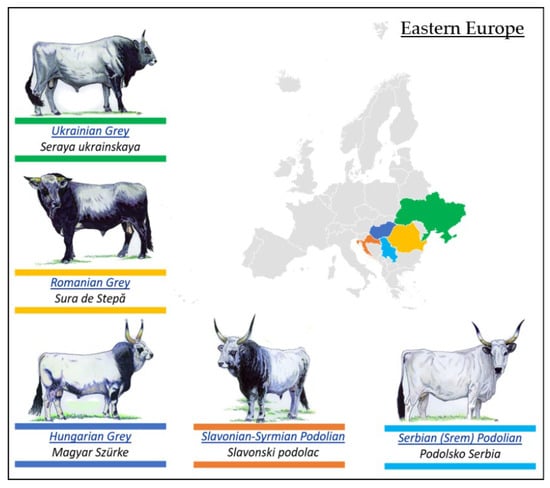
Figure 8.
Graphical representation of Podolian cattle breeds from Eastern Europe (created with Bing ©GeoNames, Microsoft, TomTom, produced by Microsoft Corporation—Redmond, WA, USA).
- Romanian Grey Steppe Breed
In Romania, the last local cattle breed is Romanian Grey Steppe, which has the wild ox, B. t. primigenius, as its ancestor and is included in the group of Podolian cattle breeds together with other breeds from various European countries []. Developed over many centuries, this breed has evolved exclusively under the influence of natural environmental conditions. The number of individuals in Romania was predominant until the middle of the 19th century; however, starting from the 20th century, an increasingly pronounced decline was recorded. It was spread across four geographical areas of the country in the form of four varieties named after the area of formation: Moldavian, Ialomitean, Transylvanian, and Dobrogean varieties [,]. According to F.A.O. reports regarding the risk status of the breed, the Grey Steppe is endangered.
- Ukrainian Grey Breed
The Ukrainian Grey breed, with its origins in B. t. primigenius, is one of the oldest native breeds that is currently endangered. The evolution of this breed has been characterized by a lack of interbreeding for several centuries. While it exhibits an exclusive capacity for resistance and fattening, it demonstrates lower performance in milk production. Simultaneously, this breed serves as an intriguing research tool. These cattle proved to be indispensable to peasants and represented the most numerous breeds in Ukraine until the 20th century, being widely distributed in the southern part of Europe and the steppe zone of the Mediterranean coast and Black Sea [].
- Hungarian Grey Breed
The Hungarian Grey is an indigenous breed, representing a national symbol of Hungary. There are several theories regarding the origin of this breed, one of which is that it arrived in the Pannonian Basin, where domestication also took place, together with Hungarian immigration in the 9th century, during the reign of King Árpád, having descended from wild boar (B. t. primigenius) []. The first written document that refers to Hungarian Grey cattle is entitled “Magnus cornuotes boves Hungaricos” and dates back to the 16th century. The breed was bred specifically for its exceptional meat quality. By 1925, after the First World War when Hungary lost about 72% of its territory, there were approximately 321,000 specimens of the Hungarian Grey breed []. Currently, the herd of cattle of this breed is facing a sharp decline.
- Slavonian–Syrmian Podolian Breed
The Slavonian–Syrmian Podolian is a native cattle species found in Slavonia, a region in the northeastern part of Croatia. These cattle are irreplaceable for agricultural activities because of their physical strength and endurance. In Podravina, Slavonia, and Syrmia, this breed was predominant until the first half of the 20th century, representing 90% of all cattle [,]. Since 1998, this breed has been included in a national genetic conservation program, and since 2000, according to the F.A.O., it is endangered, along with other breeds of Podolian cattle.
- Serbian (Srem) Podolian Breed
The Serbian (Srem) Podolian breed in Serbia faced gradual replacement due to the extensive importation of specialized cattle breeds for meat and milk production. In the early 20th century, native cattle accounted for 83% of the total population. Among the autochthonous breeds in Serbia, two varieties, Busha and Podolian, have been identified, and they are currently classified as endangered [].
3.2.3. Podolian Cattle Breeds from Italy and Istria
In Italy and Istria, five breeds of the Podolian group have been distinguished over time: Istrian cattle (Boškarin), Mursi, Istarsko (Istarsko govedo), Maremmana, and Podolica (Figure 9).

Figure 9.
Graphical representation of Podolian cattle breeds from Italy and Istria (created with Bing ©GeoNames, Microsoft, TomTom, produced by Microsoft Corporation—Redmond, WA, USA).
- Boškarin or Istrian Breed
Indigenous cattle, also called Boškarin or Istrian cattle, are widespread on the Istrian Peninsula. The breed belongs to the group of Podolian cattle found in the Balkans and neighboring countries (Croatia, Bulgaria, Greece, Hungary, Italy, Romania, Serbia, Turkey, and Ukraine), with direct descent from the aurochs (B. t. primigenius) []. Over the past 50 years, the cattle population in Istria has experienced a significant decline. Similar to the situation with the Romanian Grey Steppe, the Boškarin breed is also endangered.
- Mursi Breed
Mursi cattle are widespread in the South Omo area of southwestern Ethiopia []. They typically have inward-curving horns, prominent humps, and well-developed bodies. They have a combination of colors: grey, white, and black, with spots or stripes. The Mursi breed is raised mainly for high milk production, but it also lends itself well to meat production.
- Istarsko Govedo Breed
Istarsko govedo is a domestic cattle breed recognized for producing high-quality meat. It is currently on the verge of extinction, and the size of the population has decreased sharply since the second half of the 20th century. The conservation program for this breed was launched in the early 1990s [].
- Maremana and Podolica Breeds
The cattle breeds of Italy, namely, the Maremana and Podolica, were very popular and widespread in this area before the Second World War but saw a consistent reduction in their numbers due to three major factors: mechanization in agriculture, urbanization, and breed competition with high production efficiency. Their numbers of 288,000 and 630,000 heads [] were reduced by 90% and 80%, respectively []. The two breeds belong to the group of grey cattle whose ancestral origin is B. primigenius [].
3.2.4. Podolian Cattle Breeds from Balkans and Anatolia
In the Balkans and Anatolia regions, four breeds of Podolian cattle have spread over time: Bulgarian Grey (Iskar), Katerini cattle, Sykia cattle, and Anatolian Grey (Figure 10).
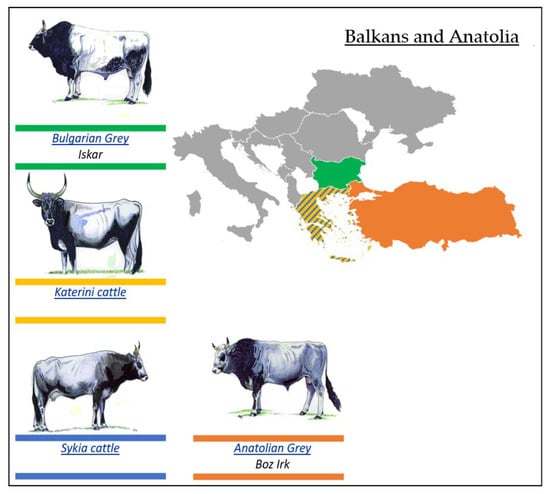
Figure 10.
Graphical representation of Podolian cattle breeds from Balkans and Anatolia (created with Bing ©GeoNames, Microsoft, TomTom, produced by Microsoft Corporation—Redmond, WA, USA).
- Bulgarian Grey (Iskar) Breed
According to studies in the field of cattle phylogeny, based on craniological analyses [,,,], the Bulgarian Grey (Iskar) breed is the result of the cross between B. taurus brachiceros and B. t. primigenius. The breed is characterized by high vitality and fertility, ease of calving, resistance to parasitic and infectious diseases, and low feed requirements. Currently, there are fewer than 1000 heads. Cattle are mainly distributed in the regions of Plovdiv, Haskovo, and Shumen and in the mountainous regions of Strandzha and Sakar. Bulgarian Grey is the first native cattle included in the National Program for the Conservation of Genetic Resources of Animal Origin [,], representing a valuable genetic reserve for Bulgaria.
- Katerini Breed
Katerini cattle is a breed with a special quality of meat production. Similar to other Podolian cattle breeds, their ancestral origin is B. t. primigenius []. From the reports issued by the F.A.O. regarding the risk status of this breed, it appears that it is at critical risk, with the effective population size gradually decreasing.
- Sykia Cattle Breed
Sykia cattle is another ancient breed found in Greece that is currently on the verge of extinction, mainly due to random crossbreeding []. Current data suggest that there are less than 200 purebred females, with the F.A.O., placing the breed in the critical risk class in terms of herd size [].
- Anatolian Grey Breed
Anatolian Grey is a cattle population widespread in Turkey. Currently, the numerical status of this Anatolian breed is critical []. To protect these genetic resources, a national project was initiated in Turkey with the main objective of in vitro conservation and identification of valuable genetic resources of native cattle [,], resulting in a numerical increase in the population of the Anatolian Grey breed through different breeding biotechnologies.
According to certain researchers, there are distinct phenotypic features observed in Podolian cattle. Long horns, characteristic of breeds like Hungarian Grey, Katerini, or Slavonian–Syrmian, are considered breed-specific traits. However, some breeds, including Podolica Italiana, Romanian Grey Steppe, Ukrainian Grey, Turkish Grey, and other Balkan breeds, may not necessarily exhibit long horns but retain other characteristics, such as the light grey color in adult cows [].
4. Trends and Management Recommendations in Genetic Conservation Programs, including the Endangered Grey Steppe Cattle
The production systems of Podolian cattle are rooted in a combination of traditional breeding practices, extensive grazing management, and recognition of the breed’s economic and cultural importance. As agriculture progresses, maintaining a balance between modern techniques and the preservation of indigenous breeds, like Podolian cattle, becomes essential for sustainable and resilient food production systems. Typically, Podolian breeds are raised in pastures, offering an environment that allows animals to exhibit their natural behaviors.
Natural pastures allow selection among a diverse array of herbaceous and arboreal plants based on nutrient requirements and individual preferences and influenced by physical characteristics, accessibility, and palatability. Thus, akin to wild herbivores, Podolian cattle have the opportunity to exhibit their natural behavior and choose a balanced diet based on their evolving nutritional requirements and physiological conditions. This capacity is deemed crucial for ensuring the welfare of the animals [,]. Another important aspect is that the reproductive characteristics of Podolian cattle are influenced by environmental factors. Podolian cattle are recognized for a significant increase in births during the spring season, when natural pastures and meadows are at maximum productivity, with direct effects on the physiological state of cows and milk production. Despite the cost-effectiveness of rearing, the trade in calves is contingent on age and live weight, reaching its peak between August and December (age 15–18 months) [,,].
The preservation of the gene pool of the Grey Steppe cattle breed requires the application of additional measures and the allocation of considerable financial resources. To design appropriate and effective conservation strategies, accurate knowledge of all existing individuals within a population must be considered. The present tools for genomic evaluation have made it possible to use mitochondrial DNA as a tool for phylogenetic and biodiversity studies []. The methods used to analyze the phylogeny of cattle have progressed from traditional morphometric analyses to contemporary molecular genetics techniques.
Further research considering the analysis of the complete mitochondrial genome, Y chromosome, and microsatellite analysis, as well as the study of DNA extracted from fossils or bone remains belonging to taurine with direct descent in B. taurus, could provide a better understanding of the genetic structure and evolutionary history of this breed [,].
Animal husbandry and cattle breeding technologies are currently facing several problems, such as the conservation of breeds at risk of abandonment, sustainable management of genetic resources, and appropriate management. To ensure sustainability, modern animal husbandry, classic breeding, and selection programs are insufficient. In addition to being expensive in terms of time and money, they are characterized by limited accuracy. The limitations imposed by these classic techniques can be eliminated by applying modern reproduction techniques (in vitro fertilization and embryo transfer), to which genetic screening methods can be added. An important aspect of ensuring an effective conservation program is the preservation of genetic material by cryogenically freezing samples (tissue and genomic DNA) and creating a database of archived samples, phenotypic parameters, and genotypic profiles of each individual to ensure propagation (Figure 11) [,].
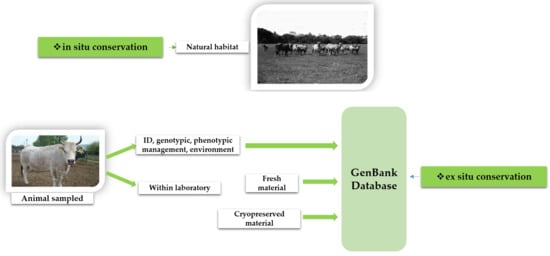
Figure 11.
In situ and ex situ genetic conservation plan for Podolian cattle breeds.
The European representatives of the (F.A.O.) have classified Podolian Grey Steppe cattle as endangered and in urgent need of conservation to preserve genetic diversity. Currently, several European countries, including Romania, are attempting to implement in situ conservation programs for Podolian cattle breeds. These projects aim to ensure a natural habitat similar to that in the wild, in which cattle can manifest their innate behavior and benefit from environmental conditions favorable to their growth and development. In addition, a series of methods for conserving the genetic resources of these cattle breeds ex situ (e.g., cryopreservation, such as processing and freezing of genetic material, and DNA banks) have been implemented, all of which aim to preserve the biodiversity of Podolian cattle breeds threatened with extinction [,,].
The issue of maintaining and conserving local breeds is important for ensuring the food security of the population, not only considering the recent climate changes as well as extreme phenomena, which could bring new challenges in the future. Bovine species are the most exposed to these changes; therefore, the Grey Steppe breed could be an effective alternative to improved breeds because of its special qualities of resistance and adaptability to different stress factors and diseases.
5. Conclusions
The information presented in this study regarding the genetic diversity, origin, and phylogeny of Podolian cattle breeds demonstrates their ancestral origin, with direct descent from B. t. primigenius (the aurochs). Their biologically valuable characteristics, such as rusticity, high longevity, adaptability, hardiness, and resistance to diseases, are important aspects of breeding and conservation programs.
According to the cited studies, it has been concluded that many populations of cattle from Eastern Europe, including the Romanian Grey Steppe, have a high level of genetic diversity and close phylogenetic relationships with wild ox.
The information presented in this study can help to improve the present conservation program to preserve biodiversity and protect Podolian Grey breeds from genetic loss, contributing to the general knowledge of the genetic diversity of European cattle breeds and could prove a valuable tool for conservation efforts of animal genetic resources.
Therefore, we strongly recommend taking immediate action and allocating appropriate financial resources to conserve the valuable genetic diversity of the Romanian Grey cattle breed, which still represents a valuable gene pool. Preserving Podolian Grey cattle from extinction will yield benefits for both the agricultural sector and the international genetic heritage.
Author Contributions
The review paper was designed by M.-A.D. The data was collected by M.-A.D., A.U., Ș.C., C.P. and R.-M.R.-R. The paper was written by M.-A.D. Conceptualization, M.-A.D.; validation, M.-A.D. and C.P.; writing—review and editing, M.-A.D., Ș.C. and A.U.; supervision, M.-A.D., R.-M.R.-R. and Ș.C. All authors have read and agreed to the published version of the manuscript.
Funding
This research received no external funding.
Institutional Review Board Statement
Not applicable.
Data Availability Statement
Data sharing is not applicable to this article.
Conflicts of Interest
The authors declare no conflict of interest.
References
- Senczuk, G.; Guerra, L.; Mastrangelo, S.; Campobasso, C.; Zoubeyda, K.; Imane, M.; Marletta, D.; Kusza, S.; Karsli, T.; Gaouar, S.B.S.; et al. Fifteen Shades of Grey: Combined Analysis of Genome-Wide SNP Data in Steppe and Mediterranean Grey Cattle Sheds New Light on the Molecular Basis of Coat Color. Genes 2020, 11, 932. [Google Scholar] [CrossRef] [PubMed]
- Loftus, R.T.; MacHugh, D.E.; Bradley, D.G.; Sharp, P.M.; Cunningham, E.P. Evidence for two independent domestications of cattle. Proc. Natl. Acad. Sci. USA 1994, 91, 2757–2761. [Google Scholar] [CrossRef] [PubMed]
- MacHugh, D.E.; Shriver, M.D.; Loftus, R.T.; Cunningham, P.; Bradley, D.G. Microsatellite DNA variation and the evolution, domestication and phylogeography of taurine and zebu cattle (Bos taurus and Bos indicus). Genetics 1997, 146, 1071–1086. [Google Scholar] [CrossRef] [PubMed]
- Verdugo, M.P.; Mullin, V.E.; Scheu, A.; Mattiangeli, V.; Daly, K.G.; Maisano Delser, P.; Hare, A.J.; Burger, J.; Collins, M.J.; Kehati, R.; et al. Ancient cattle genomics, origins, and rapid turnover in the Fertile Crescent. Science 2019, 365, 173–176. [Google Scholar]
- Rieznykova, N.L. Grey Ukrainian cattle breed as the ancestor of Podolic (Podolian) group. J. Anim. Breed. Genet. 2021, 62, 165–190. [Google Scholar] [CrossRef]
- Maretto, F.; Ramljak, J.; Sbarra, F.; Penasa, M.; Mantovani, R.; Ivankovic, A. Genetic relationship among Italian and Croatian Podolian cattle breeds assessed by microsatellite markers. Livest. Sci. 2012, 13, 256. [Google Scholar] [CrossRef]
- D’Andrea, M.; Pariset, L.; Matassino, D.; Valentini, A.; Lenstra, A.J.; Maiorano, G.; Pilla, F. Genetic characterization and structure of the Italian Podolian cattle breed and its relationship with some major European breeds. Ital. J. Anim. Sci. 2011, 10, 237–243. [Google Scholar] [CrossRef]
- Hiendleder, S.; Lewalski, H.; Janke, A. Complete mitochondrial genomes of Bos taurus and Bos indicus provide new insights into intraspecies variation, taxonomy and domestication. Cytogenet. Genome Res. 2008, 120, 150–156. [Google Scholar] [CrossRef]
- Edwards, C.J.; Bollongino, R.; Scheu, A.; Chamberlain, A.; Tresset, A.; Vigne, J.D.; Baird, J.F.; Larson, G.; Ho, S.Y.; Heupink, T.H.; et al. Mitochondrial DNA analysis shows a Near Eastern Neolithic origin for domestic cattle and no indication of domestication of European aurochs. Proc. Biol. Sci. 2007, 274, 1377–1385. [Google Scholar] [CrossRef]
- Buttar, I.; Solounias, N. Specialized Position of the Horns, and Frontal and Parietal Bones in Bos taurus (Bovini, Artiodactyla), and Notes on the Evolution of Bos. Ann. Zool. Fenn. 2021, 58, 49–63. [Google Scholar] [CrossRef]
- Davidescu, M.A.; Grădinaru, A.C.; Creangă, Ș. Endangered Romanian cattle breeds—Between traditional breeding and genetic conservation. In Proceedings of the International Scientific Congress—Life Sciences, a Challenge for the Future, Iași, Romania, 17–18 October 2019; pp. 339–349. [Google Scholar]
- Dascălu, D.L.; Creangă, Ș.; Borș, S.I.; Doliș, M.G.; Simeanu, D.; Donosă, R. The Romanian Grey Steppe characterization—The breed evolution in the last century from the numerical and morphological point of view. Danub. Anim. Genet. Resour. 2017, 2, 70–75. [Google Scholar]
- Scherf, B.D. World Watch List for Domestic Animal Diversity, 3rd ed.; FAO: Rome, Italy, 2000; Available online: http://www.fao.org/docrep/009/x8750e/x8750e00.htm (accessed on 14 February 2023).
- Teneva, A.; Todorovska, E.; Tyufekchiev, N.; Kozelov, L.; Atanassov, A.; Foteva, S.; Ralcheva, S.; Zlatarev, S. Molecular characterization of Bulgarian livestock genetic resources: Genetic diversity in Bulgarian grey cattle as revealed by microsatellite markers. Biotechnol. Anim. Husb. 2005, 21, 35–42. [Google Scholar] [CrossRef]
- Pariset, L.; Mariotti, M.; Nardone, A.; Soysal, M.I.; Ozkan, E.; Williams, J.L.; Dunner, S.; Leveziel, H.; Maroti-Agots, A.; Bodo, I.; et al. Relationships between Podolic cattle breeds assessed by single nucleotide polymorphisms (SNPs) genotyping. J. Anim. Breed. Genet. 2010, 127, 481–488. [Google Scholar] [CrossRef] [PubMed]
- Creangă, Ş.; Maciuc, V.; Pîntea, M. Genetic Polymorphism in Cattle Breeding in Moldova; Ion Ionescu de la Brad: Iaşi, Romania, 2008; pp. 86–87. ISBN 978-973-147024-5. [Google Scholar]
- Creangă, S.; Maciuc, V. Romanian Grey Steppe; Alfa: Iaşi, Romania, 2010; pp. 145–147. ISBN 978-606-540-034-4. [Google Scholar]
- Mastrangelo, S.; Tolone, M.; Ben Jemaa, S.; Sottile, G.; Di Gerlando, R.; Cortés, O.; Senczuk, G.; Portolano, B.; Pilla, F.; Ciani, E. Refining the genetic structure and relationships of European cattle breeds through meta-analysis of worldwide genomic SNP data, focusing on Italian cattle. Sci. Rep. 2020, 10, 14522. [Google Scholar] [CrossRef]
- Creangă, S.; Chelmu, S.S.; Maciuc, V.; Bâlteanu, V.A. Molecular characterization of Grey Steppe cattle breed for its genetic bio-preservation. Rom. Biotechnol. Lett. 2013, 18, 8893–8900. [Google Scholar]
- Maciuc, V.; Radu-Rusu, R.M. Assessment of Grey Steppe cattle genetic and phenotypic traits as valuable resources in preserving biodiversity. Environ. Eng. Manag. J. 2018, 17, 2741–2748. [Google Scholar]
- Bâlteanu, A.V.; Pop, D.F.; Vlaic, A.; Carsai, C.T.; Creangă, Ş.; Rusu, R.A. Characterization of the άs1 Casein IRV allele provides evidence for phylogeny of the ancient Romanian Grey Steppe cattle, Moldavian strain. Int. J. Vet. Sci. Anim. Husb. 2010, 53, 167–172. [Google Scholar]
- Bâlteanu, V.A.; Vlaic, A.; Rusu, A.R.; Creangă, Ş.; Pop, F.D.; Odagiu, A.; Pântea, M.L.; Hâncu, V. Milk proteins polymorphism in Romanian Grey Steppe cattle studied by isoelectric focusing technique (IEF). Identification of a new allele alpha S1-casein allele: Alpha S1 IRV. Bull. USAMV-CN Anim. Sci. Biotechnol. 2007, 63, 304–310. [Google Scholar]
- Ilie, D.E.; Cean, A.; Cziszter, L.T.; Gavojdian, D.; Ivan, A.; Kusza, S. Microsatellite and Mitochondrial DNA study of native Eastern European cattle populations: The case of the Romanian Grey. PLoS ONE 2015, 10, e0138736. [Google Scholar] [CrossRef]
- Baumung, R.; Sölkner, J. Analysis of pedigrees of Tux-Zillertal, Carinthian Blond and Original Pinzgau cattle population in Austria. J. Anim. Breed. Genet. 2002, 119, 175–181. [Google Scholar] [CrossRef]
- Sölkner, I.; Filipcic, L.; Hampshire, N. Genetic variability of populations and similarity of subpopulations in Austrian cattle breeds determined by analysis of pedigrees. Anim. Sci. 2010, 67, 249–256. [Google Scholar] [CrossRef]
- Hristov, P.; Teofanova, D.; Neov, B.; Shivachev, B.; Radoslavov, G. Mitochondrial diversity in autochthonous cattle breeds from the Balkan Peninsula. Czech. J. Anim. Sci. 2015, 60, 311–318. [Google Scholar] [CrossRef]
- Srivastava, A.K.; Patel, J.B.; Ankuya, K.J.; Chauhan, H.D.; Pawar, M.M.; Gupta, J.P. Conservation of Indigenous Cattle Breeds. J. Anim. Res. 2019, 1, 1–12. [Google Scholar] [CrossRef]
- Barnes, K.; Collins, T.; Dion, S.; Reynolds, H.; Riess, S.; Stanzyk, A.; Wolfe, A.; Lonergan, S.; Boettcher, P.; Charrondiere, U.R.; et al. Importance of cattle biodiversity and its influence on the nutrient composition of beef. Anim. Front. 2012, 2, 54–60. [Google Scholar] [CrossRef][Green Version]
- Zeder, M.A.; Bradley, D.; Emshwiller, E.; Smith, B.D. Documenting Domestication New Genetic and Archaeological Paradigms, 1st ed.; University of California Press: Berkeley, CA, USA, 2006; p. 375. ISBN 9780520246386. [Google Scholar]
- Clutton-Brock, J. A Natural History of Domesticated Mammals, 2nd ed.; Cambridge University Press: Cambridge, UK, 1999; pp. 114–127. ISBN 0521634954. [Google Scholar]
- Diamond, J. Evolution, consequences and future of plant and animal domestication. Nature 2002, 418, 700–707. [Google Scholar] [CrossRef] [PubMed]
- Groeneveld, L.F.; Lenstra, J.A.; Eding, H.; Toro, M.A.; Scherf, B.; Pilling, D. Genetic diversity in farm animals—A review. Anim. Genet. 2010, 41, 6–31. [Google Scholar] [CrossRef] [PubMed]
- Achilli, A.; Olivieri, A.; Pellecchia, M.; Uboldi, C.; Colli, L. Mitochondrial genomes of extinct aurochs survive in domestic cattle. Curr. Biol. 2008, 18, 157–158. [Google Scholar] [CrossRef]
- Achilli, A.; Bonfiglio, S.; Olivieri, A.; Malusà, A.; Pala, M. The multifaceted origin of taurine cattle reflected by the mitochondrial genome. PLoS ONE 2009, 4, e5753. [Google Scholar] [CrossRef]
- Hassanin, A.; Ropiquet, A. Molecular phylogeny of the tribe Bovini (Bovidae, Bovinae) and the taxonomic status of the Kouprey, Bos sauveli Urbain. Mol. Phylogenet. Evol. 2005, 33, 896–907. [Google Scholar] [CrossRef]
- Götherström, A.; Anderung, C.; Hellborg, L.; Elburg, R.; Smith, C.; Bradley, D.G.; Ellegren, H. Cattle domestication in the Near East was followed by hybridization with aurochs bulls in Europe. Proc. Biol. Sci. 2005, 22, 1579–2345. [Google Scholar] [CrossRef]
- Pitt, D.; Sevane, N.; Nicolazzi, E.L.; MacHugh, D.E.; Park, S.D.E.; Colli, L.; Martinez, R.; Bruford, M.W.; Orozco-terWenge, P. Domestication of cattle: Two or three events? Evol. Appl. 2019, 12, 123–136. [Google Scholar] [CrossRef] [PubMed]
- Meadow, R.H. Animal Domestication in the Middle East: A Revised View from the Eastern Margin, 2nd ed.; Possehl, G.L., Ed.; Harappan Civilization: A Recent Perspective; American Institute of Indian Studies and Oxford & IBH Pub.: New Delhi, India, 1993; pp. 295–321. ISBN 8120407792. [Google Scholar]
- Park, S.D.E.; Magee, D.A.; McGettigan, P.A.; Teasdale, M.D.; Edwards, C.J.; Lohan, A.J.; Murphy, A.; Braud, M.; Donoghue, M.T.; Liu, Y.; et al. Genome sequencing of the extinct Eurasian wild aurochs, Bos primigenius, illuminates the phylogeography and evolution of cattle. Genome Biol. 2015, 16, 234. [Google Scholar] [CrossRef] [PubMed]
- Upadhyay, M.R.; Chen, W.; Lenstra, J.A.; Goderie, C.R.J.; MacHugh, D.E.; Park, S.D.E.; Magee, D.A.; Matassino, D.; Ciani, F.; Megens, H.J.; et al. Genetic origin, admixture and population history of aurochs (Bos primigenius) and primitive European cattle. Heredity 2017, 118, 169–176. [Google Scholar] [CrossRef]
- Scheu, A.; Hartz, S.; Schmölcke, U.; Tresset, A.; Burger, J.; Bollongino, R. Ancient DNA provides no evidence for independent domestication of cattle in Mesolithic Rosenhof, Northern Germany. J. Archaeol Sci. 2008, 35, 1257–1264. [Google Scholar] [CrossRef]
- Taberlet, P.; Valentini, A.; Rezaei, H.R.; Naderi, S.; Pompanon, F.; Negrini, R.; Ajmone-Marsan, P. Are cattle, sheep, and goats endangered species? Mol. Ecol. 2008, 17, 275–284. [Google Scholar] [CrossRef] [PubMed]
- Taberlet, P.; Coissac, E.; Pansu, J.; Pompanon, F. Conservation genetics of cattle, sheep, and goats. C. R. Biol. 2011, 334, 247–254. [Google Scholar] [CrossRef]
- Bradley, D.G.; Magee, D.A. Genetics and the Origins of Domestic Cattle. In New Genetics and Archaeological Paradigms; University of California Press, Ltd.: Berkeley, CA, USA, 2006; pp. 317–328. [Google Scholar] [CrossRef]
- Sinding, M.H.S.; Gilbert, M.T.P. The Draft Genome of Extinct European Aurochs and its Implications for De-Extinction. Open Quat. 2016, 2, 7. [Google Scholar] [CrossRef]
- Bollongino, R.; Edwards, C.J.; Alt, K.W.; Burger, J.; Bradley, D.G. Early history of European domestic cattle as revealed by ancient DNA. Biol. Lett. 2006, 2, 155–159. [Google Scholar] [CrossRef]
- Bollongino, R.; Elsner, J.; Vigne, J.D.; Burger, J. Y-SNPs do not indicate hybridisation between European aurochs and domestic cattle. PLoS ONE 2008, 3, e3418. [Google Scholar] [CrossRef]
- Vigne, J.D.; Helmer, D.; Peters, J. New archaeozoological approaches. In First Steps of Animal Domestication, Proceedings of the 9th Conference of the International Council of Archaeozoology; Oxbow Books: Durham, UK, 2005; pp. 1–41. ISBN 1842171216. [Google Scholar]
- Savage, D.E.; Russell, D.E. Mammalian Paleofaunas of the World; Addison-Wesley Publishing Company: Boston, MA, USA, 1983; p. 432. ISBN 0201064944. [Google Scholar] [CrossRef]
- Elsik, C.G.; Tellam, R.L.; Worley, K.C.; Gibbs, R.A.; Muzny, D.M.; Weinstock, G.M. The genome sequence of taurine cattle: A window to ruminant biology and evolution. Science 2009, 324, 522–528. [Google Scholar] [CrossRef]
- Dekel, Y.; Machluf, Y.; Ben-Dor, S.; Yifa, O.; Stoler, A.; Ben-Shlomo, I.; Bercovich, D. Dispersal of an ancient retroposon in the TP53 promoter of Bovidae: Phylogeny, novel mechanisms, and potential implications for cow milk persistency. BMC Genom. 2015, 16, 53. [Google Scholar] [CrossRef] [PubMed]
- Arif, I.A.; Bakir, M.A.; Khan, H.A. Inferring the Phylogeny of Bovidae Using Mitochondrial DNA Sequences: Resolving Power of Individual Genes Relative to Complete Genomes. Evol. Bioinform. 2012, 8, 139–150. [Google Scholar] [CrossRef]
- Bibi, F. A multi-calibrated mitochondrial phylogeny of extant Bovidae (Artiodactyla, Ruminantia) and the importance of the fossil record tosystematics. BMC Evol. Biol. 2013, 13, 166. [Google Scholar] [CrossRef] [PubMed]
- Matthee, C.A.; Davis, S.K. Molecular insights into the evolution of the family Bovidae: A nuclear DNA perspective. Mol. Biol. Evol. 2001, 18, 1220. [Google Scholar] [CrossRef]
- Feldhamer, G.; Drickamer, L.; Vessey, S.; Merritt, J.; Krajewski, C. Mammalogy: Adaptation, Diversity, Ecology, 1st ed.; The Johns Hopkins University Press: Baltimore, MD, USA, 2007; pp. 156–158. ISBN 1421436523. [Google Scholar]
- Gentry, A. Bovidae. In Paleontology and Geology of Laetoli: Human Evolution in Context: Fossil Hominins and the Associated Fauna; Harrison, T., Ed.; Springer: New York, NY, USA, 2011; Volume 2, pp. 363–465. [Google Scholar] [CrossRef]
- Hernandez-Fernandez, M.; Vrba, E.S. A complete estimate of the phylogenetic relationships in Ruminantia: A dated species-level super tree of the extant ruminants. Biol. Rev. 2005, 80, 269–302. [Google Scholar] [CrossRef] [PubMed]
- Vrba, E.S.; Schaller, G.B. Phylogeny of Bovidae based on behavior, glands, skulls, and postcrania. In Antelopes, Deer, and Relatives; Yale University Press: New Haven, CT, USA; London, UK, 2000; pp. 203–222. [Google Scholar]
- Wilson, D.E.; Reeder, D.A.M. Mammal Species of the World, 3rd ed.; Johns Hopkins University Press: Baltimore, MD, USA, 2005; p. 2142. ISBN 978-0-8018-8221-0. [Google Scholar]
- Cotterill, F.P.D. The Upemba lechwe, Kobus anselli: An antelope new to science emphasizes the conservation importance of Katanga, Democratic Republic of Congo. J. Zool. 2005, 265, 113–132. [Google Scholar] [CrossRef]
- Harrison, T. Paleontology and Geology of Laetoli Human Evolution in Context; Springer: Dordrecht, The Netherlands, 2011; pp. 363–465. ISBN 978-9048-199-624. [Google Scholar]
- Demiguel, D.; Sánchez, I.M.; Alba, D.M.; Galindo, J.; Robles, J.M.; Moyà-Solà, S. First evidence of Azanza and Morales, (Ruminantia, Bovidae), in the Miocene of the Vallès-Penedès Basin (Spain). J. Vertebr. Paleontol. 2012, 32, 57–62. [Google Scholar] [CrossRef]
- Geraads, D.; El Boughabi, S.; Zouhri, S. A new caprin bovid (Mammalia) from the late Miocene of Morocco. Palaeontol. Afr. 2012, 47, 19–24. [Google Scholar]
- Li, M.H.; Tapio, I.; Vilkki, J.; Ivanova, Z.; Kiselyova, T.; Marzanov, N.; Ćinkulov, M.; Stojanović, S.; Ammosov, I.; Popov, R.; et al. The genetic structure of cattle populations (Bos taurus) in northern Eurasia and the neighbouring Near Eastern regions: Implications for breeding strategies and conservation. Mol. Ecol. 2007, 16, 3839–3853. [Google Scholar] [CrossRef]
- Soysal, M.I.; Kök, S. The last survivors of Grey cattle resisting extinction. A case study of characteristics and sustainability of traditional systems of native Grey cattle breeds, in Olaizola. Mediterr. Livest. Prod. Uncertain. Oppor. 2008, 78, 55–63. [Google Scholar]
- Davidescu, M.-A.; Simeanu, D.; Gorgan, D.-L.; Ciorpac, M.; Creanga, S. Analysis of Phylogeny and Genetic Diversity of Endangered Romanian Grey Steppe Cattle Breed, a Reservoir of Valuable Genes to Preserve Biodiversity. Agriculture 2022, 12, 2059. [Google Scholar] [CrossRef]
- Yilmaz, O.; Akin, O.; Yener, S.; Ertugrul, M.; Wilson, R. The domestic livestock resources of Turkey: Cattle local breeds and types and their conservation status. Anim. Genet. Resour. 2012, 50, 65–73. [Google Scholar] [CrossRef]
- Palova, N.; Krusheva, D. Conservation of genetic resources in livestock breeding in the Experimental Station of Agriculture—Sredets. Türk Tarım ve Doğa Bilimleri Dergisi 2014, 6, 1106–1111. [Google Scholar]
- Senczuk, G.; Mastrangelo, S.; Ajmone-Marsan, P.; Becskei, Z.; Colangelo, P.; Colli, L.; Ferretti, L.; Karsli, T.; Lancioni, H.; Lasagna, E.; et al. On the origin and diversification of Podolian cattle breeds: Testing scenarios of European colonization using genome-wide SNP data. Genet. Sel. 2021, 53, 48. [Google Scholar] [CrossRef] [PubMed]
- Curik, I.; Ferenčaković, M.; Karapandza, N.; Cubric Curik, V.; Sölkner, V. Estimation of inbreeding and effective population size in Istrian cattle using molecular information. Acta Agrar. Debr. 2014, 18, 30–34. [Google Scholar]
- Ramljak, J.; Ivanković, A.; Veit-Kensch, C.E.; Förster, M.; Medugorac, I. Analysis of genetic and cultural conservation value of three indigenous Croatian cattle breeds in a local and global context. J. Anim. Breed. Genet. 2010, 128, 73–84. [Google Scholar] [CrossRef]
- Keros, T.; Jemeršić, L.; Prpić, J.; Brnić, D. Molecular Characterization of Autochtonus Slavonian Syrmian Podolian Cattle. Acta Vet. 2015, 65, 89–98. [Google Scholar] [CrossRef][Green Version]
- Karatosidi, D.; Marsico, G.; Ligda, C.; Tarricone, S. Assessment of the meat quality of Italian Podolian and Greek Katerini cattle. Anim. Genet. Resour. 2013, 53, 141–146. [Google Scholar] [CrossRef]
- Antonopoulos, D.; Vougiouklaki, D.; Laliotis, G.P.; Tsironi, T.; Valasi, I.; Chatzilazarou, A.; Halvatsiotis, P.; Houhoula, D. Identification of Polymorphisms of the CSN2 Gene Encoding β-Casein in Greek Local Breeds of Cattle. Vet. Sci. 2021, 8, 257. [Google Scholar] [CrossRef]
- Török, P.; Valkó, O.; Deák, B.; Kelemen, A.; Tóth, E.; Tóthmérész, B. Managing for species composition or diversity? Pastoral and free grazing systems in alkali steppes. Agric. Ecosyst. Environ. 2016, 234, 23–30. [Google Scholar] [CrossRef]
- Tóth, E.; Deák, B.; Valkó, O.; Kelemen, A.; Miglécz, T.; Tóthmérész, B.; Török, P. Livestock Type is More Crucial Than Grazing Intensity: Traditional Cattle and Sheep Grazing in Short-Grass Steppes. Land Degrad. Dev. 2018, 29, 231–239. [Google Scholar] [CrossRef]
- Öner, Y.; Yılmaz, O.; Eriş, C.; Ata, N.; Ünal, C.; Koncagül, S. Genetic diversity and population structure of Turkish native cattle breeds. S. Afr. J. Anim. 2019, 49, 628–635. [Google Scholar] [CrossRef]
- Demir, E.; Balcioğlu, M.S. Genetic diversity and population structure of four cattle breeds raised in Turkey using microsatellite markers. Czech J. Anim. Sci. 2019, 64, 411–419. [Google Scholar] [CrossRef]
- Mokhnachova, N.; Suprovich, T.; Dobrynska, M.; Fursa, N. Characteristics of Ukrainian Grey cattle by DNA-markers. J. Anim. Breed. 2018, 51, 283–289. [Google Scholar] [CrossRef]
- Svishcheva, G.; Babayan, O.; Lkhasaranov, B.; Tsendsuren, A.; Abdurasulov, A.; Stolpovsky, Y. Microsatellite Diversity and Phylogenetic Relationships among East Eurasian Bos taurus Breeds with an Emphasis on Rare and Ancient Local Cattle. Animals 2020, 10, 1493. [Google Scholar] [CrossRef] [PubMed]
- Beja-Pereira, A.; Caramelli, D.; Lalueza-Fox, C.; Vernesi, C.; Ferrand, N.; Casoli, A.; Goyache, F.; Royo, L.J.; Conti, S.; Lari, M.; et al. The origin of European cattle: Evidence from modern and ancient DNA. Proc. Natl. Acad. Sci. USA 2006, 21, 8113–8118. [Google Scholar] [CrossRef]
- Pellecchia, M.; Negrini, R.; Colli, L.; Patrini, M.; Milanesi, E.; Achilli, A.; Bertorelle, G.; Cavalli-Sforza, L.L.; Piazza, A.; Torroni, A.; et al. The mystery of Etruscan origins: Novel clues from Bos taurus mitochondrial DNA. Proc. R. Soc. Biol. Sci. 2007, 274, 1175–1179. [Google Scholar] [CrossRef]
- Di Lorenzo, P.; Lancioni, H.; Ceccobelli, S.; Colli, L.; Cardinali, I.; Karsli, T.; Capodiferro, M.R.; Sahin, E.; Ferretti, L.; Ajmone Marsan, P.; et al. Mitochondrial DNA variants of Podolian cattle breeds testify for a dual maternal origin. PLoS ONE 2018, 13, e0192567. [Google Scholar] [CrossRef]
- Carșai, T.C.; Vlaic, A.; Coșier, V.; Bâlteanu, A.V. Research on the Polymorphism at the Leptin Gene Locus for Selection Purposes Assisted by Genetic Markers in Cattle; Bioflux: Cluj-Napoca, Romania, 2008; pp. 47–84. [Google Scholar]
- Creangă, Ş.; Dascălu, D.; Ruginosu, E.; Borş, I.; Ilie, D.E.; Cean, A. Demographic Study on the total Grey Steppe Breed Population in Romania. Agron. Res. Mold. 2013, 46, 85–97. [Google Scholar]
- Georgescu, S.E.; Manea, M.A.; Zaulet, M.; Costache, M. Genetic diversity among Romanian cattle breeds with a special focus on the Romanian Grey Steppe Breed. Rom. Biotechnol. Lett. 2009, 14, 4194–4200. [Google Scholar]
- Gradinaru, A.C.; Petrescu-Mag, I.V.; Oroian, F.C.; Balint, C.; Oltean, I. Milk Protein Polymorphism Characterization: A Modern Tool for Sustainable Conservation of Endangered Romanian Cattle Breeds in the Context of Traditional Breeding. Sustainability 2018, 10, 534. [Google Scholar] [CrossRef]
- Bâlteanu, A.V.; Vlaic, A.; Pop, F.D.; Rusu, A.R.; Martin, P.; Miranda, G.; Creangă, Ș. Characterization at protein level of the new αs1 casein allele IRV discovered in Romanian Grey Steppe cattle breed Moldavian variety. Sci. Pap. Anim. Husb. Biotechnol. Ser. 2008, 41, 1–10. [Google Scholar]
- Ilie, D.E.; Creangă, Ș.; Grădinaru, A.C.; Borș, S.I.; Dascălu, D.L.; Chirilă, D.; Cean, A. Genetic diversity of Romanian Grey Steppe cattle based on milk protein polymorphism. J. Biotechnol. 2014, 185, S49. [Google Scholar] [CrossRef]
- Senczuk, G.; Mastrangelo, S.; Ciani, E.; Battaglini, L.; Cendron, F.; Ciampolini, R.; Crepaldi, P.; Mantovani, R.; Bongioni, G.; Pagnacco, G.; et al. The genetic heritage of Alpine local cattle breeds using genomic SNP data. Genet. Sel. Evol. 2020, 52, 40. [Google Scholar] [CrossRef] [PubMed]
- Kushniraand, A.V.; Glazko, V.I. Gray Ukrainian Cattle and Their Closely Related Forms. Contemp. Probl. Ecol. 2009, 2, 288–295. [Google Scholar] [CrossRef]
- Holló, G.; Nuernberg, K.; Somogyi, T.; Anton, I.; Holló, I. Comparison of fattening performance and slaughter value of local Hungarian cattle breeds to international breeds. Arch. Anim. Breed. 2012, 55, 1–12. [Google Scholar] [CrossRef]
- Zsolnai, A.; Maróti-Agóts, A.; Kovács, A.; Bâlteanu, A.V.; Kaltenecker, E.; Anton, I. Genetic position of Hungarian Grey among European cattle and identification of breed-specific markers. Animal 2002, 14, 1786–1792. [Google Scholar] [CrossRef] [PubMed]
- Poljak, F.; Ilkić, J.; Čuklić, D.; Pintić, V.; Ernoić, M. Basic external characteristics and measurements of Slavonian-Sirmian Podolian cattle. Stočarstvo 2002, 56, 105–116. [Google Scholar]
- Caput, P.; Ivanković, A.; Konjačić, M. Genome typing of autochthonous breeds of domestic animals in Croatia. Stočarstvo 2004, 58, 265–293. [Google Scholar]
- Bogdanovic, V.; Djedovic, R.; Perisic, P.; Petrovic, M.M. Cattle breeding goals and programmes in Serbia. Biotechnol. Anim. Husb. 2005, 21, 15–21. [Google Scholar] [CrossRef]
- Terefe, E.; Haile, A.; Mulatu, W.; Dessie, T.; Mwai, O. Phenotypic characteristics and trypanosome prevalence of Mursi cattle breed in the Bodi and Mursi districts of South Omo Zone, southwest Ethiopia. Trop. Anim. Health Prod. 2015, 47, 485–493. [Google Scholar] [CrossRef]
- Moioli, B.; Napolitano, F.; Catillo, G. Genetic Diversity between Piedmontese, Maremmana, and Podolica Cattle Breeds. J. Hered. 2004, 95, 250–256. [Google Scholar] [CrossRef]
- Ivanković, A.; Caput, P.; Prekalj, G.; Kelava, N.; Konjačić, M.; Šubara, G.; Šuran, E. Characteristics of the Istrian cattle in beef production. Stočarstvo 2010, 64, 91–99. [Google Scholar]
- Blackburn, H.D.; Wilson, C.S.; Krehbiel, B. Conservation and Utilization of Livestock Genetic Diversity in the United States of America through Gene Banking. Diversity 2019, 11, 244. [Google Scholar] [CrossRef]
- Neov, B.; Teofanova, D.; Zagorchev, L.; Radoslavov, G.; Hristov, P. Milk protein polymorphism in bulgarian grey cattle population. Bulg. J. Agric. Sci. 2013, 19, 194–196. [Google Scholar]
- Hunter, P. The genetics of domestication: Research into the domestication of livestock and companion animals sheds light both on their “evolution” and human history. EMBO Rep. 2018, 19, 201–205. [Google Scholar] [CrossRef] [PubMed]
- Ozsensoy, Y.; Kurar, E. Genetic diversity of native Turkish cattle breeds: Mantel, AMOVA and bottleneck analysis. J. Adv. Vet. Anim. Res. 2014, 1, 86–93. [Google Scholar] [CrossRef]
- Cosentino, C.; D’Adamo, C.; Naturali, N.; Pecora, G.; Paolino, R.; Musto, M.; Adduci, F.; Freschi, P. Podolian cattle: Reproductive activity, milk and future prospects. Ital. J. Agron. 2018, 13, 982. [Google Scholar] [CrossRef]
- Napolitano, F.; Pacelli, C.; DeRosa, G.; Braghieri, A.; Girolami, A. Sustainability and welfare of Podolian cattle. Livest. Prod. Sci. 2005, 92, 323–331. [Google Scholar] [CrossRef]
- Napolitano, F.; Girolami, A.; Pacelli, C.; Braghieri, A. Activity Budgets and Forage Selection of Podolian Cattle, a Semiwild Bovine Breed. Int. Sch. Res. Netw. 2011, 2011, 972804. [Google Scholar] [CrossRef]
- Ginja, C.; Gama, L.T.; Cortés, O.; Burriel, I.M.; Vega-Pla, J.L.; Penedo, C.; Sponenberg, P.; Cañón, J.; Sanz, A.; do Egito, A.A.; et al. The Genetic Ancestry of American Creole Cattle Inferred from Uniparental and Autosomal Genetic Markers. Sci. Rep. 2019, 9, 11486. [Google Scholar] [CrossRef] [PubMed]
- Loftus, R.; Scherf, B. World Watch List for Domestic Animal Diversity, 1st ed.; FAO/UNEP: Rome, Italy, 1993; Available online: https://www.fao.org/3/y0741t/y0741t.pdf (accessed on 25 January 2023).
- Rischkowsky, B.; Pilling, D. The First Report on the State of the World’s Animal Genetic Resources for Food and Agriculture; FAO: Rome, Italy, 2007; Available online: https://www.fao.org/3/a1260e/a1260e.pdf (accessed on 18 February 2023).
- FAO. Commission on Genetic Resources for Food and Agriculture Assessments; FAO: Rome, Italy, 2015; Available online: https://www.fao.org/cgrfa/en (accessed on 22 February 2023).
Disclaimer/Publisher’s Note: The statements, opinions and data contained in all publications are solely those of the individual author(s) and contributor(s) and not of MDPI and/or the editor(s). MDPI and/or the editor(s) disclaim responsibility for any injury to people or property resulting from any ideas, methods, instructions or products referred to in the content. |
© 2023 by the authors. Licensee MDPI, Basel, Switzerland. This article is an open access article distributed under the terms and conditions of the Creative Commons Attribution (CC BY) license (https://creativecommons.org/licenses/by/4.0/).



